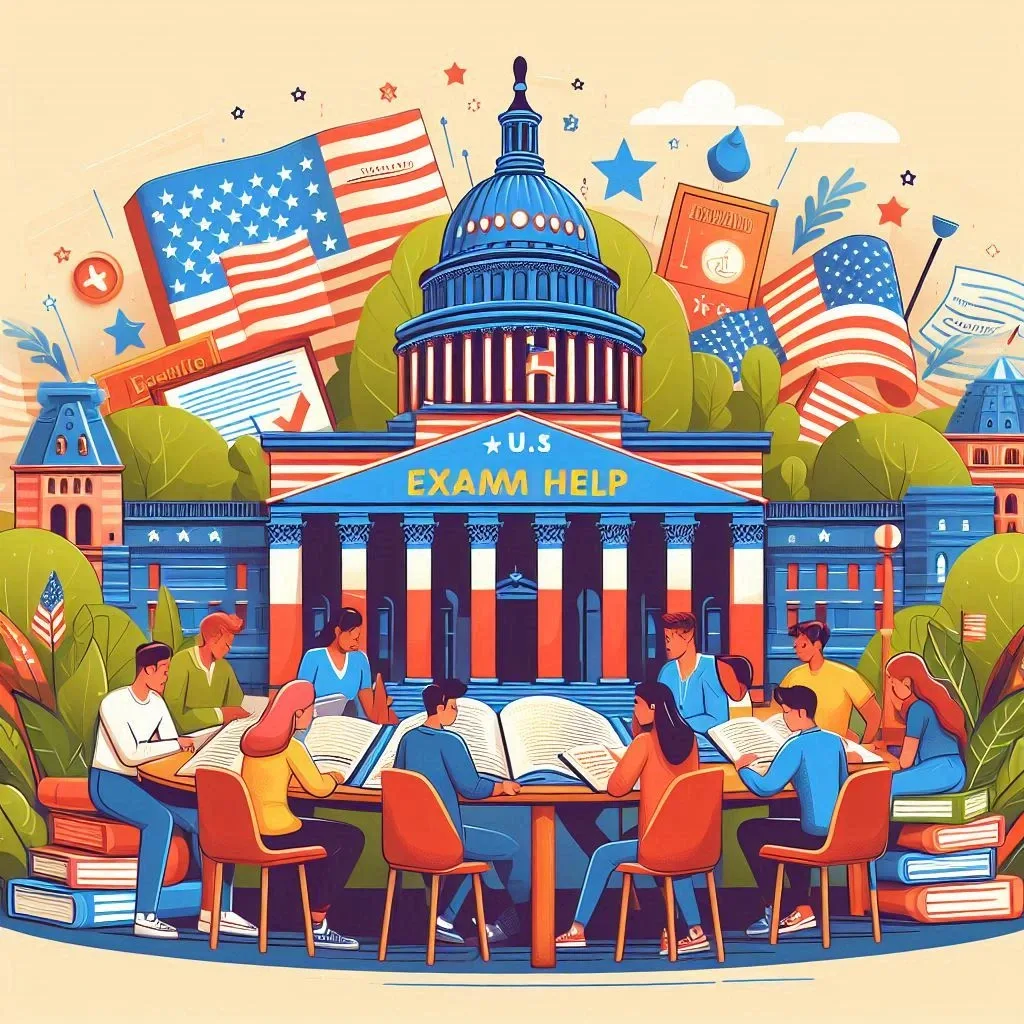U.S. Constitution and American Politics Exam Preparation

Preparing for an American Politics exam, particularly one focused on the U.S. Constitution and Founding Principles, requires much more than simple memorization. It calls for a thoughtful understanding of the philosophical roots, historical background, and modern relevance of the ideas that shaped the United States. The Constitution was not a sudden creation but the result of deliberate debates and compromises—an ongoing experiment in self-governance that still evolves today. For students who often wonder, “Can someone take my American Politics exam for me?” or seek the support of an Online Exam Taker, it’s essential to remember that true success lies in understanding rather than shortcuts. These exams test your ability to analyze, reason, and connect historical principles with modern governance. This blog will help you prepare effectively for exams that cover popular sovereignty, natural rights, liberty, equality, and social contract theory. You’ll also discover how to approach theoretical and analytical questions with confidence—crafting answers that demonstrate deep conceptual understanding, critical thinking, and your ability to apply foundational ideas of democracy in real-world contexts.

Understanding the Foundation: The Evolution of Self-Government
The story of the U.S. Constitution begins long before 1787. It was shaped by centuries of political thought and practical experience. Between the Declaration of Independence (1776) and the Constitution (1787), the United States operated under the Articles of Confederation, which proved too weak to sustain a growing nation. The framers learned valuable lessons from that period — lessons about the balance between liberty and order, power and accountability.
To prepare for exam questions in this area, students should:
- Understand chronology — know how colonial experiences and the failures of the Articles influenced the need for a new constitution.
- Connect philosophy and practice — link Enlightenment ideas (Locke, Rousseau, Montesquieu) to the creation of American institutions.
- Memorize key transitions — such as from the Articles to the Constitution and the ratification debates between Federalists and Anti-Federalists.
Exam tip: When answering essay questions about the “birth of the Constitution,” begin by establishing the historical context, then explain how philosophical ideals were adapted to practical governance.
Founding Principles: The Heart of the Constitution
The U.S. Constitution embodies several enduring principles that remain central to American political life. Understanding these is essential not just for exams, but for understanding the nature of democracy itself.
Popular Sovereignty
At its core, popular sovereignty asserts that power originates with the people. Unlike monarchies where authority flows from rulers, the American system is built on the consent of the governed. This is captured in the iconic opening — “We the People.”
When preparing for exams:
- Know the definition: Popular sovereignty means that the government’s authority comes from the people.
- Understand its implications: It’s the foundation of democracy, voting rights, and public accountability.
- Use examples: The ratification process of the Constitution and later expansions of suffrage illustrate the evolution of this principle.
Exam strategy: For multiple-choice or short-answer questions, focus on keywords like consent of the governed, sovereignty of the people, or ratification. For essays, connect this principle to the Preamble and social contract theory.
Natural Rights
Rooted in Enlightenment thought, particularly John Locke’s philosophy, natural rights are those inherent to every individual — life, liberty, and the pursuit of happiness. These rights are not granted by governments but must be protected by them.
Preparation tips:
- Study the Declaration of Independence and its assertion of unalienable rights.
- Understand how the Constitution and the Bill of Rights institutionalize these principles.
- Recognize the tension between security and freedom — a theme often explored in exams.
In the exam hall: If asked to define or analyze natural rights, emphasize that they are pre-political — they exist before and beyond any government. Link this to the due process clause of the Fifth and Fourteenth Amendments.
Equality
Equality is the cornerstone of justice in a constitutional democracy. Initially, “We the People” applied narrowly, but over time, through amendments and social movements, it expanded to include all citizens.
When studying equality:
- Review the Fourteenth Amendment (1868), which guarantees equal protection under the law.
- Understand how this amendment transformed American society, particularly during Reconstruction and the Civil Rights Movement.
- Recognize that equality is both a moral ideal and a legal principle — shaping judicial decisions from Brown v. Board of Education to Obergefell v. Hodges.
Exam technique: For analytical essays, compare how equality was interpreted in 1787 versus how it evolved post-Reconstruction. Mention the amendment’s impact on citizenship, civil rights, and liberty.
Liberty
Liberty is perhaps the most complex of all principles. It involves both freedom from government interference (negative liberty) and freedom to pursue one’s goals (positive liberty).
To master this topic:
- Study how the concept of liberty appears in the Preamble, Bill of Rights, and Fourteenth Amendment.
- Distinguish between civil liberties (freedom of speech, religion, press) and civil rights (protection from discrimination).
- Understand how liberty and equality coexist — sometimes in harmony, sometimes in tension.
In exams: Define liberty precisely and use historical examples, such as how liberty expanded through landmark Supreme Court rulings. Avoid vague generalizations — examiners reward depth of understanding.
The Social Contract: The Agreement Behind Government
The social contract theory forms the philosophical bedrock of the Constitution. It holds that individuals consent to give up some freedoms to a government that, in return, protects their rights and maintains order.
For preparation:
- Study John Locke’s Two Treatises of Government.
- Understand how the framers applied this concept to create a limited government accountable to the people.
- Learn how this principle legitimizes the right to revolution when governments fail to protect citizens’ rights — as articulated in the Declaration of Independence.
Exam approach: When asked to explain the social contract, structure your answer like this:
- Define the theory.
- Link it to Enlightenment philosophy.
- Explain its application in the Constitution and modern democracy.
- From the Articles of Confederation to a Stronger Union.
A common exam topic involves comparing the Articles of Confederation with the Constitution.
Under the Articles, the national government was weak — there was no power to tax, regulate trade, or enforce laws. Events like Shays’ Rebellion exposed its flaws, convincing leaders that a stronger federal system was necessary.
Key contrasts to memorize:
- The Articles emphasized state sovereignty, while the Constitution established a federal system.
- The new government introduced separation of powers and checks and balances.
- Ratification debates revealed the ongoing struggle between liberty and order.
Exam tip: For essays, begin with the weaknesses of the Articles, explain the motivations for change, and conclude with how the Constitution addressed those issues.
The Ongoing Experiment: Redefining “We the People”
One of the most insightful exam themes is the evolution of inclusion in American democracy. Initially, the phrase “We the People” excluded many — women, enslaved individuals, Indigenous populations, and non-property owners. Over time, these groups used the Constitution’s own language to demand equality.
When preparing:
- Study amendments that expanded democracy — the 13th, 14th, 15th, 19th, and 26th.
- Connect social movements to constitutional change.
- Analyze how the principle of equality evolved from theory to practice.
In exams: When faced with essay questions on inclusivity or social progress, demonstrate that the Constitution is a living document — one that adapts through amendments, interpretation, and civic engagement.
Analytical Thinking: Applying Principles to Modern Contexts
Many exams don’t just test knowledge — they test your ability to apply historical principles to current events.
For example, you might be asked:
- How does popular sovereignty operate in modern elections?
- How is liberty challenged by technology and surveillance?
- What does equality mean in the context of voting rights today?
Study method:
- Keep up with current affairs — constitutional issues in the news often echo founding debates.
- Relate modern Supreme Court cases to original principles.
- Develop your ability to form balanced arguments — showing how ideals like liberty and equality can sometimes conflict.
Exam Hall Strategies: Handling Constitutional Questions with Confidence
Even the best preparation can falter under exam pressure. Here’s how to handle questions effectively:
Read the Question Carefully
Exams on the U.S. Constitution often use nuanced wording. Watch for distinctions like liberty vs. equality or rights vs. responsibilities. Underline key terms and identify whether the question asks for definition, analysis, or evaluation.
Use a Logical Framework
Structure your essay using the PEEL method — Point, Evidence, Explanation, Link.
Example:
- Point: The Constitution embodies the principle of popular sovereignty.
- Evidence: This is expressed in the phrase “We the People” and through the ratification process.
- Explanation: It shows that political power derives from citizens, not monarchs.
- Link: This principle remains vital in modern debates over voter access and representation.
Balance Facts and Analysis
Don’t just memorize amendments — explain their impact. Use historical evidence, philosophical ideas, and real-world examples to build credibility.
Manage Time Wisely
Allocate time based on marks. For essays, spend a few minutes planning your structure before writing. Always leave time to review and refine your arguments.
Avoid Common Pitfalls
- Don’t oversimplify — the Constitution is complex, and examiners value nuanced understanding.
- Avoid presentism — don’t judge 18th-century decisions by 21st-century standards.
- Don’t rely solely on memorized definitions — connect principles to their historical roots and modern applications.
Continuing the Experiment: Civic Responsibility in Action
Exams on the U.S. Constitution aren’t just academic exercises — they test your understanding of citizenship and responsibility. As Albert Einstein once said, “The strength of the Constitution lies entirely in the determination of each citizen to defend it.”
Students should not only learn what the Constitution says but also why it matters today. Understanding concepts like popular sovereignty and equality encourages participation in democracy — voting, civic debate, and advocacy.
When you internalize these ideas, you become more than a student of politics; you become a steward of democracy.
Conclusion
Preparing for American politics exams is as much about understanding principles as it is about recalling facts. The Constitution represents an ongoing conversation about power, justice, and freedom — one that every generation must revisit. By studying deeply, connecting ideas across history and law, and thinking critically in the exam hall, students can master not only their exams but also the very foundation of American governance. Whether it’s popular sovereignty, natural rights, equality, or liberty, each principle is a reminder that democracy is not static — it’s an evolving agreement between the people and their government. And in that agreement lies both our history and our future.